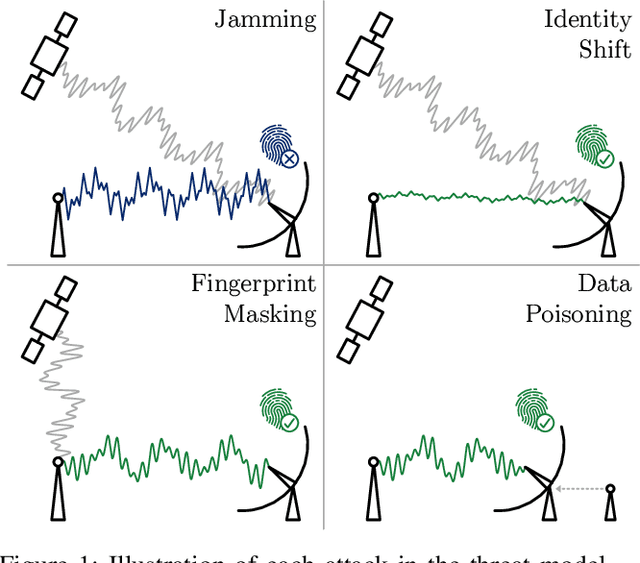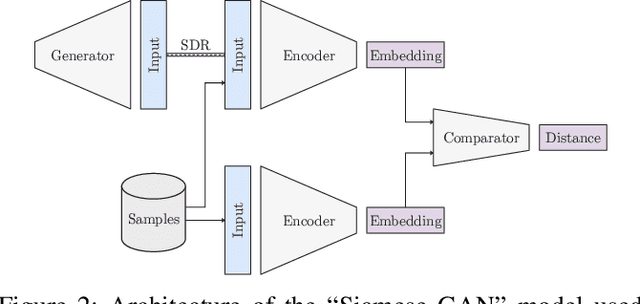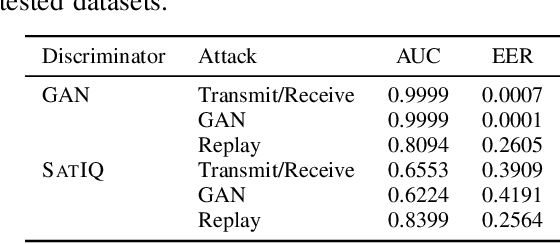Simon Birnbach
SATversary: Adversarial Attacks on Satellite Fingerprinting
Jun 06, 2025



Abstract:As satellite systems become increasingly vulnerable to physical layer attacks via SDRs, novel countermeasures are being developed to protect critical systems, particularly those lacking cryptographic protection, or those which cannot be upgraded to support modern cryptography. Among these is transmitter fingerprinting, which provides mechanisms by which communication can be authenticated by looking at characteristics of the transmitter, expressed as impairments on the signal. Previous works show that fingerprinting can be used to classify satellite transmitters, or authenticate them against SDR-equipped attackers under simple replay scenarios. In this paper we build upon this by looking at attacks directly targeting the fingerprinting system, with an attacker optimizing for maximum impact in jamming, spoofing, and dataset poisoning attacks, and demonstrate these attacks on the SatIQ system designed to authenticate Iridium transmitters. We show that an optimized jamming signal can cause a 50% error rate with attacker-to-victim ratios as low as -30dB (far less power than traditional jamming) and demonstrate successful identity forgery during spoofing attacks, with an attacker successfully removing their own transmitter's fingerprint from messages. We also present a data poisoning attack, enabling persistent message spoofing by altering the data used to authenticate incoming messages to include the fingerprint of the attacker's transmitter. Finally, we show that our model trained to optimize spoofing attacks can also be used to detect spoofing and replay attacks, even when it has never seen the attacker's transmitter before. Furthermore, this technique works even when the training dataset includes only a single transmitter, enabling fingerprinting to be used to protect small constellations and even individual satellites, providing additional protection where it is needed the most.
Watch This Space: Securing Satellite Communication through Resilient Transmitter Fingerprinting
May 11, 2023Abstract:Due to an increase in the availability of cheap off-the-shelf radio hardware, spoofing and replay attacks on satellite ground systems have become more accessible than ever. This is particularly a problem for legacy systems, many of which do not offer cryptographic security and cannot be patched to support novel security measures. In this paper we explore radio transmitter fingerprinting in satellite systems. We introduce the SatIQ system, proposing novel techniques for authenticating transmissions using characteristics of transmitter hardware expressed as impairments on the downlinked signal. We look in particular at high sample rate fingerprinting, making fingerprints difficult to forge without similarly high sample rate transmitting hardware, thus raising the budget for attacks. We also examine the difficulty of this approach with high levels of atmospheric noise and multipath scattering, and analyze potential solutions to this problem. We focus on the Iridium satellite constellation, for which we collected 1010464 messages at a sample rate of 25 MS/s. We use this data to train a fingerprinting model consisting of an autoencoder combined with a Siamese neural network, enabling the model to learn an efficient encoding of message headers that preserves identifying information. We demonstrate the system's robustness under attack by replaying messages using a Software-Defined Radio, achieving an Equal Error Rate of 0.120, and ROC AUC of 0.946. Finally, we analyze its stability over time by introducing a time gap between training and testing data, and its extensibility by introducing new transmitters which have not been seen before. We conclude that our techniques are useful for building systems that are stable over time, can be used immediately with new transmitters without retraining, and provide robustness against spoofing and replay by raising the required budget for attacks.
They See Me Rollin': Inherent Vulnerability of the Rolling Shutter in CMOS Image Sensors
Jan 25, 2021



Abstract:Cameras have become a fundamental component of vision-based intelligent systems. As a balance between production costs and image quality, most modern cameras use Complementary Metal-Oxide Semiconductor image sensors that implement an electronic rolling shutter mechanism, where image rows are captured consecutively rather than all-at-once. In this paper, we describe how the electronic rolling shutter can be exploited using a bright, modulated light source (e.g., an inexpensive, off-the-shelf laser), to inject fine-grained image disruptions. These disruptions substantially affect camera-based computer vision systems, where high-frequency data is crucial in extracting informative features from objects. We study the fundamental factors affecting a rolling shutter attack, such as environmental conditions, angle of the incident light, laser to camera distance, and aiming precision. We demonstrate how these factors affect the intensity of the injected distortion and how an adversary can take them into account by modeling the properties of the camera. We introduce a general pipeline of a practical attack, which consists of: (i) profiling several properties of the target camera and (ii) partially simulating the attack to find distortions that satisfy the adversary's goal. Then, we instantiate the attack to the scenario of object detection, where the adversary's goal is to maximally disrupt the detection of objects in the image. We show that the adversary can modulate the laser to hide up to 75% of objects perceived by state-of-the-art detectors while controlling the amount of perturbation to keep the attack inconspicuous. Our results indicate that rolling shutter attacks can substantially reduce the performance and reliability of vision-based intelligent systems.
 Add to Chrome
Add to Chrome Add to Firefox
Add to Firefox Add to Edge
Add to Edge